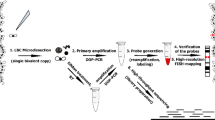Abstract
The tufted deer, a species found only in China, has polymorphic sex chromosomes (2n = 46, 47, 48). Centrins are centrosome components in species from yeast to humans. Here, the Cetn1 gene was isolated from the testis cDNA library of tufted deer, and its expression pattern, number of gene copies, and gene structure were studied. To date, for unknown reasons, satisfactory genomic DNA of the tufted deer has not been obtained. In the present study, we extracted high molecular weight genomic DNA from tissues of the tufted deer. Results showed that genomic DNA was isolated successfully and could be used for Southern blotting of the Cetn1 gene. Centrin 1 transcripts were shown to exist in testis and the retina. It has no intron and only a single copy in the genome. Protein sequence analyses indicate that the C-terminal Ser-170, which was shown to be phosphorylated in human centrin, is not conserved except in sequences from the human, chimpanzee, and tufted deer.






Similar content being viewed by others
References
Araki M, Masutani C, Takemura M, Uchida A, Sugasawa K, Kondoh J, Ohkuma Y, Hanaoka F (2001) Centrosome protein centrin 2/caltractin 1 is part of the xeroderma pigmentosum group C complex that initiates global genome nucleotide excision repair. J Biol Chem 276:18665–18672
Cao X, Jiang H, Zhang X (2005) Polymorphic karyotypes and sex chromosomes in the tufted deer (Elaphodus cephalophus): cytogenetic studies and analyses of sex chromosome-linked genes. Cytogenet Genome Res 109:512–518
Carlström G, Chazin WJ (1993) Two-dimensional 1H nuclear magnetic resonance studies of the half-saturated (Ca++)1 state of calbindin D9 k. Further implications for the molecular basis of cooperative Ca++ binding. J Mol Biol 231:415–430
Errabolu R, Sanders MA, Salisbury JL (1994) Cloning of a cDNA encoding human centrin, an EF-hand protein of centrosomes and mitotic spindle poles. J Cell Sci 107:9–16
Friedberg F (2006) Centrin isoforms in mammals. Relation to calmodulin. Mol Biol Rep 33:243–252
Gavet O, Alvarez C, Gaspar P, Bornens M (2003) Centrin4p, a novel mammalian centrin specifically expressed in ciliated cells. Mol Biol Cell 14:1818–1834
Giessl A, Pulvermüller A, Trojan P, Park JK, Choe H-W, Ernst OP, Hofmann KP, Wolfrum U (2004) Differential expression and interaction with the visual G-protein transducin of centrin isoforms in mammalian photoreceptor cells. J Biol Chem 279:51472–51481
Giessl A, Trojan P, Rausch S, Pulvermüller A, Wolfrum U (2006) Centrins, gatekeepers for the light-dependent translocation of transducin through the photoreceptor cell connecting cilium. Vision Res 46:4502–4509
Hart PE, Glantz JN, Orth JD, Poynter GM, Salisbury JL (1999) Testis-specific murine centrin, Centrin1: genomic characterization and evidence for retroposition of a gene encoding a centrosome protein. Genomics 60:111–120
Khalfan W, Ivanovska I, Rose MD (2000) Functional interaction between the PKC1 pathway and CDC31 network of SPB duplication genes. Genetics 155:1543–1559
Laird PW, Zijderveld A, Linders K, Rudnicki MA, Jaenisch R, Berns A (1991) Simplified mammalian DNA isolation procedure. Nucleic Acids Res 19:4293
Lee VD, Huang B (1993) Molecular cloning and centrosomal localization of human caltractin. Proc Natl Acad Sci 90:11039–11043
Lutz W, Lingle WL, McCormick D, Greenwood TM, Salisbury JL (2001) Phosphorylation of centrin during the cell cycle and its role in centriole separation preceding centrosome duplication. J Biol Chem 276:20774–20780
Madeddu L, Klotz C, Le Caer JP, Beisson J (1996) Characterization of centrin genes in Paramecium. Eur J Biochem 238:121–128
Middendorp S, Paoletti A, Schiebel E, Bornens M (1997) Identification of a new mammalian centrin gene, more closely related to Saccharomuces cerevisiae CDC31 gene. Proc Natl Acad Sci 94:9141–9146
Nishi R, Okuda Y, Watanabe E, Mori T, Iwai S, Masutani C, Sugasawa K, Hanaoka F (2005) Centrin 2 stimulates nucleotide excision repair by interacting with xeroderma pigmentosum group C protein. Mol Cell Biol 25:5664–5674
Popescu A, Miron S, Blouquit Y, Duchambon P, Christova P, Craescu CT (2003) Xeroderma pigmentosum group C protein possesses a high affinity binding site to human centrin 2 and calmodulin. J Biol Chem 278:40252–40261
Pulvermüller A, Giessl A, Heck M, Wottrich R, Schmitt A, Ernst OP, Choe HW, Hofmann KP, Wolfrum U (2002) Calcium-dependent assembly of centrin-G-protein complex in photoreceptor cells. Mol Cell Biol 22:2194–2203
Salisbury JL (1995) Centrin, centrosomes, and mitotic spindle poles. Curr Opin Cell Biol 7:39–45
Salisbury JL (2004) Primary cilia: putting sensors together. Curr Biol 14:R765–R767
Salisbury JL, Suino KM, Busby R, Springett M (2002) Centrin-2 is required for centriole duplication in mammalian cells. Curr Biol 12:1287–1292
Sanders MA, Salisbury JL (1994) Centrin plays an essential role in microtubule severing during flagellar excision in Chlamydomonas reinhardtii. J Cell Biol 124:795–805
Schiebel E, Bornens M (1995) In search of a function for centrins. Trends Cell Biol 5:197–201
Sullivan DS, Biggins S, Rose MD (1998) The yeast centrin, cdc31p, and the interacting protein kinase, Kic1p, are required for cell integrity. J Cell Biol 143:751–765
Sun X, Ge Y, Ma J, Yu Z, Li S, Wang Y, Xue S, Han D (2002) The cloning and expression characterization of the centrosome protein genes family (centrin genes) in rat testis. Sci China 45:655–662
Wiech H, Geier BM, Paschke T, Spang A, Grein K, Steinkotter J, Melkonian M, Schiebel E (1996) Characterization of green alga, yeast, and human centrins. J Bio Chem 271:22453–22461
Wolfrum U, Giessl A, Pulvermuller A (2002) Centrins, a novel group of Ca++-binding proteins in vertebrate photoreceptor cells. Adv Exp Med Biol 514:155–178
Acknowledgments
We thank Mr. Chunmao Xu and Mr. Jun Hu (Wannan First-Aid Center for Wild Animals, Anhui Province, China) for providing tufted deer samples. This study was supported by the Key Project of the Shanghai Science and Technology Committee of China (No. 063919121) and the Chinese National Natural Science Foundation (No. 30370789).
Author information
Authors and Affiliations
Corresponding author
Additional information
Wen Zhang and Xiangrong Cao contributed equally to this work.
Rights and permissions
About this article
Cite this article
Zhang, W., Cao, X., Shen, Q. et al. Isolation and Characterization of the Cetn1 Gene from Tufted Deer (Elaphodus cephalophus). Biochem Genet 46, 652–662 (2008). https://doi.org/10.1007/s10528-008-9179-1
Received:
Accepted:
Published:
Issue Date:
DOI: https://doi.org/10.1007/s10528-008-9179-1




